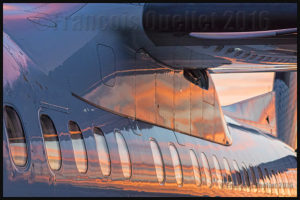The Air Canada Terminal installations at the Toronto Lester B. Pearson international airport are such that a voyager intending to do a flight from Toronto to Quebec has to walk outside the building to catch his plane. This has some advantages, especially when it is an evening flight and there is, at the time of boarding, a superb sunset.
But to directly photograph the sunset colors without any filter or tripod, while hand holding the camera, is a recipe for disaster. And a photographer cannot stay immobile for very long in that restricted area where security agents and passengers walking towards the DHC-8-400 demand that everyone move with the flow.
A practical method that offers very good results is to indirectly photograph the beautiful sunset colors by using the aircraft as a reflector.
First, it is better to use a camera lens that requires very little light. This will limit the grain size while allowing a shutter speed that is high enough to avoid a blurred picture. The scenery was thus captured with a Canon 5DSR full-frame camera equipped with a Canon EF 50mm f/1.4 USM lens.
Secondly, the photographer must crop the photography using an image editing software so that all useless details are absent from the final shot. There are two objectives: 1) it is obviously necessary to keep the aircraft parts that will best show the sunset colors and 2) do the best possible use of the elements presenting graphic interests for the viewer.
If I had kept only several oversized windows in order to show the superb sunset colours, there would have been only clear bright colours, without contrasts. That would have given an uninteresting photo. The advantages of protecting the shadowy top of the aircraft are that it adds a strong luminosity contrast, allows the inclusion of the Q-400 diagonal lines (1-2-3-4-5) and a reflection of the reflections themselves (6) under the aircraft’s wing. All this is highlighted in the photo below.
Click on the link for more aviation photos on my blog.

